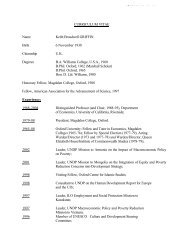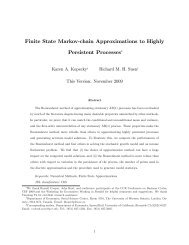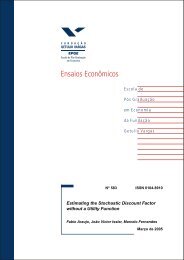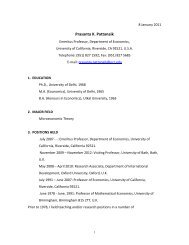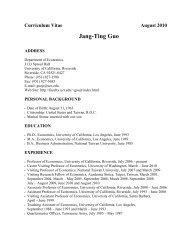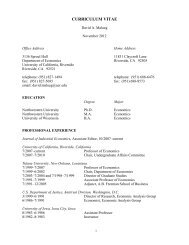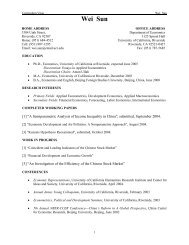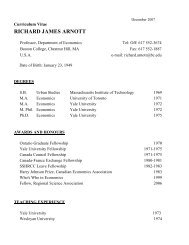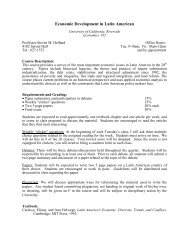Copula-based Multivariate GARCH Model with ... - Economics
Copula-based Multivariate GARCH Model with ... - Economics
Copula-based Multivariate GARCH Model with ... - Economics
Create successful ePaper yourself
Turn your PDF publications into a flip-book with our unique Google optimized e-Paper software.
Nelsen (1999, p. 121), and Embrechts et al (2003, p. 373) for derivation of<br />
F 1,··· ,m (η; θ) = C 1,··· ,m (u; θ)<br />
= ϕ −1 (ϕ (u 1 )+ϕ (u 2 )+···+ ϕ (u m )) ,<br />
where ϕ is the generator of an Archimedean copula. We discuss the m-variate Archimedean copulas<br />
in Appendix. From C 1,··· ,m (u), we derive the bivariate copula function C ij (u i ,u j ) between u i and<br />
u j by setting all u k =1, ∀k 6= i, j. Once F ij<br />
¡<br />
ηi ,η j<br />
¢<br />
= Cij (u i ,u j )(i, j =1,...,m) is obtained, σ ij<br />
is determined by Hoeffding’s Lemma.<br />
Remark 8: The associativity property of Archimedean copulas is not shared by other copulas<br />
in general and thus Method 2 is generally for Archimedean copulas.<br />
Another disadvantage of<br />
Method 2 is that it assumes the same dependence structure for all pairs of (u i ,u j ), i.e., the same<br />
copula function C ij = C <strong>with</strong> the same parameter θ ij = θ. 7 This is to set all the off-diagonal<br />
elements of Σ to take the same value (σ ij = σ), which is obviously restrictive as can be seen from<br />
estimated values of θ ij and σ ij in our empirical results (Tables 1-3) for different pairs of three<br />
foreign exchange series. While this may be restrictive for in-sample estimation especially for a large<br />
m, our empirical analysis for m =3shows this may not be a serious problem in OOS forecasting<br />
as the resulted parsimony <strong>with</strong> only one parameter can reduce the effect of parameter estimation<br />
uncertainty in OOS forecasting. 8 ¤<br />
Remark 9: Adifferent method other than the above two methods may also be possible. For<br />
example, Joe (1997, p. 156) provides a three variable extension of the Frank copula <strong>with</strong> multiple<br />
shape parameters. For more discussion of the multivariate copula functions, see Joe (1997, Sections<br />
5.3 and 5.5). We do not use this method in our empirical analysis in the next section, where we<br />
only consider Method 1 and Method 2. ¤<br />
4.2 Joint density f 1,··· ,m (η t ; θ) and the likelihood<br />
Let θ be the copula parameters and α be the M<strong>GARCH</strong> parameters to parameterize H t , e.g., DCC,<br />
VC, and BEKK as discussed in Section 2. The log-likelihood of {r t } n t=1 is<br />
L r 1,··· ,m(θ, α) =L η 1,··· ,m (θ)+ln|Σ1/2 (θ)H −1/2<br />
t (α)| (18)<br />
7 In Section 5, we use the 3-variate Frank copula as shown in (27) <strong>with</strong> m = 3. It can be easily seen that<br />
C 123 (u 1,u 2, 1; θ) =C 12 (u 1,u 2; θ) , and they have the same shape parameter θ.<br />
8 The effects of parameter estimation on prediction densities have been studied in recent literature, e.g., Pascual<br />
et al. (2001).<br />
12




